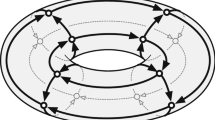Abstract
The topology of an object is commonly represented through a topological graph or a cut graph (polygonal scheme). Over the past few years, many studies have focused on extracting the topological and cut graphs of complex freeform objects that are represented by meshes. For an object with genus-n, the topological graph has n cycles, while the cut graph contains 2n cycles. These loops, however, do not always explicitly represent the holes in the objects. That is, a cycle in the graph can be a cycle around a solid (meridian), a cycle around a hole (longitude), or almost any combination of the two. The task of classifying the cycles (generators) as cycles around holes (longitude) and cycles around solids (meridians) on the mesh is not straightforward. Every closed orientable 2-manifold with genus-n can be seen as a collection of n toruses stitched together, so that each hole in the object can be referred to as a torus with two generators. This paper proposes a method that extracts the generators from which the longitudes and the meridians are found. The topological graph is defined by the longitudes and by a spanning tree constructed between them. The cut graph is constructed using the same concept. The advantage of the proposed method over other methods is that each loop in the topological graph explicitly represents a hole in the object.
Similar content being viewed by others
Explore related subjects
Discover the latest articles, news and stories from top researchers in related subjects.References
Biasotti S (2001) Topology techniques for shape understanding. In: Proceedings of the Central European seminar on computer graphics (CESCG 2001), Budmerice Castle, Slovakia, 23–25 April 2001, pp 10–14
Cohen-Or D, Sorkine O, Goldenthal R, Lischinski D (2002) Bounded – distortion piecewise mesh parametarization. In: Proceedings of IEEE Visualization’02, Boston, 27 October 2002, pp 355–362
Cormen HT, Leiserson EC, Rivest LR (1998) Introduction to algorithms. MIT Press, Cambridge, MA
DeBerg M, Kreveld MV, Overmars M, Schwarzkof O (1997) Computational geometry, algorithms and applications. Springer, Berlin Heidelberg New York
Dey TK, Guha S (1999) Transforming curves on surfaces. J Comput Sys Sci 58:297–325
Dey TK, Schipper H (1995) A new technique to compute polygonal schema for 2-manifolds with application to null-homotopy detection. Discrete Comput Geom 14:93–110
Fischer A, Manor A, Barhak J (1999) Adaptive parameterization for reconstruction of 3D freeform objects from laser-scanned data. In: Proceedings of IEEE Pacific Graphics ’99, Seoul, Korea, 5–7 October 1999
Floater MS (1997) Parameterization and smooth approximation of surface triangulation. Comput Aided Geom Des 14:231–250
Hatcher A (2000) Algebraic topology. http://www.math.cornell.edu/∼hatcher/
Helio H, Rossignac J, Safanova A, Szymczak A, Tavares G (2002) Edgebreaker: a simple compression for surfaces with handles. In: Proceedings of the 7th ACM conference on solid modeling and application, Saarbrücken, Germany, 17–21 June 2002
Hilaga M, Shinagawa Y, Kohmura T, Kunii TL (2001) Topology matching for fully automatic similarity estimation of 3D shapes. In: Proceedings of SIGGRAPH 2001, San Jose, California, 12–17 August 2001, pp 203–212
Jeff E, Sariel HP (2002) Optimally cutting a surface into a disk. In: Proceedings of the symposium on computational geometry, Barcelona, Spain, 5–7 June 2002
Kartasheva E (1999) Reduction of h-genus polyhedrons topology. Int J Shape Model 5(2):179–194
Kawauchi A (1996) A survey of knot theory. Birkhäuser, Boston
Lazarus F, Verroust A (1999) Level set diagrams of polyhedral objects. In: Proceedings of ACM Solid Modeling ’99, Ann Arbor, MI, June 1999
Lazarus F, Pocchiola M, Vegter G, Verroust A (2001) Computing a canonical polygonal schema of an orientable triangulated surface. In: Proceedings of the 17th ACM annual symposium on computational geometry, Medford, MA, 3–5 June 2001, pp 80–89
Lee Y, Kim HS, Lee S (2001) Parameterization of triangular meshes with virtual boundaries. In: Proceedings of the conference on geometrical modeling and computer graphics, Seoul , Korea, October 2001, pp 105–113
Munkers JR (1984) Elements of algebric topology. Addison-Wesley, Redwood City, CA
Shefer A, de Sturler E (2000) Surface parameterization for meshing by triangulation. In: Proceedings of the 9th international meshing roundtable, New Orleans, 2–5 October 2000, pp 161–172
Shinagawa Y, Kunii LT, Kergosien YL (1991) Surface coding based on Morse theory. IEEE Comput Graph Appl 11(5):66–78
Steiner D, Fischer A (2001) Topology recognition of 3D closed freeform objects based on topological graphs. In: Proceedings of Pacific Graphics, Tokyo, 16–18 October 2001, pp 82–88
Steiner D, Fischer A (2002) Cutting 3D freeform objects with genus-n into one-boundary surface using topological graphs. In: Proceedings of the 7th ACM conference on solid modeling and applications, Saarbrücken, Germany, 17–21 June 2002
Tai C-L, Shinagawa Y, Kunii TL (1998) A Reeb graph-based representation for non-sequential construction of topologically complex shapes. Comput Graph 22(2–3):255–268
Touma C, Gotsman C (1998) Triangle mesh compression. In: Proceedings of Graphics Interface’98, Vancouver, BC, Canada, 18–20 June 1998, pp 26–34
Tutte WT (1963) How to draw a graph. Proc Lond Math Soc 13:743–768
Ulrike A, Herbert E (1998) Auditory Morse analysis of triangulated manifolds. In: Mathematical visualization, Springer, Berlin Heidelberg New York, pp 223–236
Vegter G, Yap CK (1990) Computational complexity of combinatorial surfaces. In: Proceedings of the 6th annual ACM symposium on computational geometry, Berkeley, CA, 6–8 June 1990, pp 102–111
Xianfeng G, Gortler SJ, Hoppe H (2002) Geometry images. In: Proceedings of SIGGRAPH 2002, San Antonio, 23–25 July 2002, pp 362–371
Author information
Authors and Affiliations
Corresponding author
Rights and permissions
About this article
Cite this article
Steiner, D., Fischer, A. Finding and defining the generators of genus-n objects for constructing topological and cut graphs. Visual Comp 20, 266–278 (2004). https://doi.org/10.1007/s00371-003-0232-0
Published:
Issue Date:
DOI: https://doi.org/10.1007/s00371-003-0232-0




